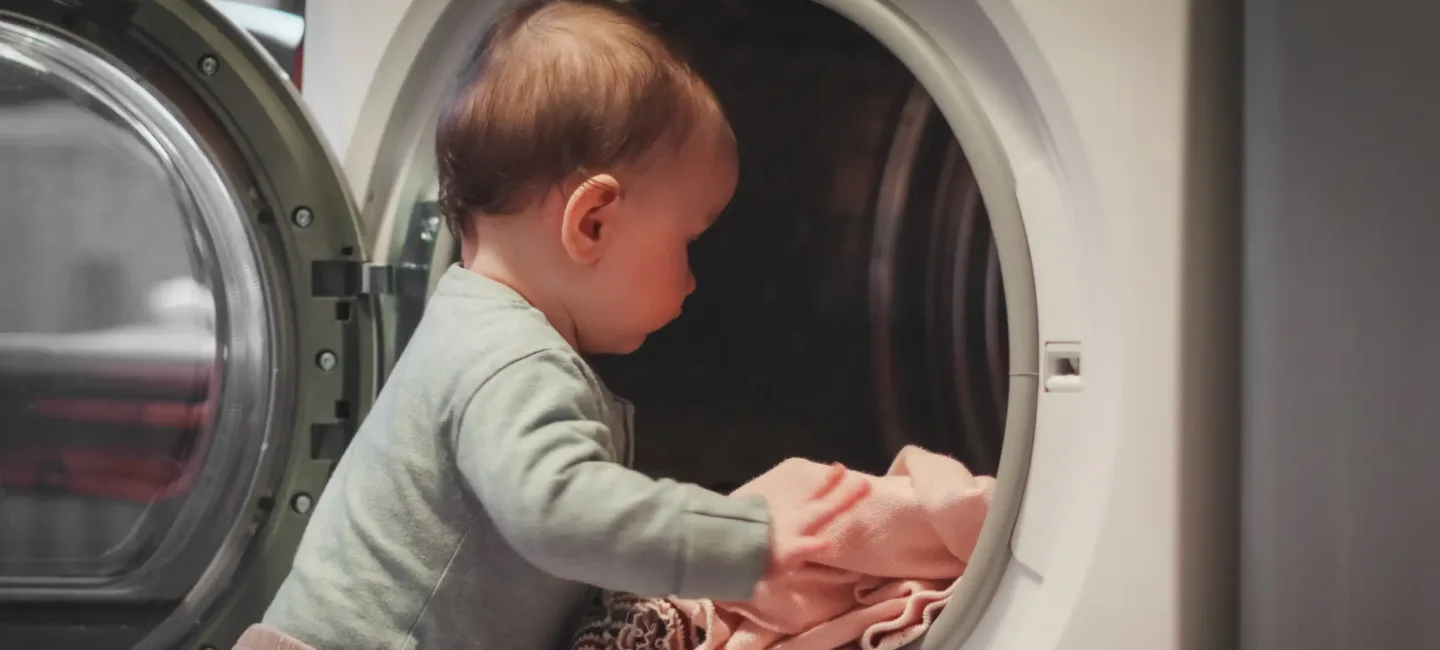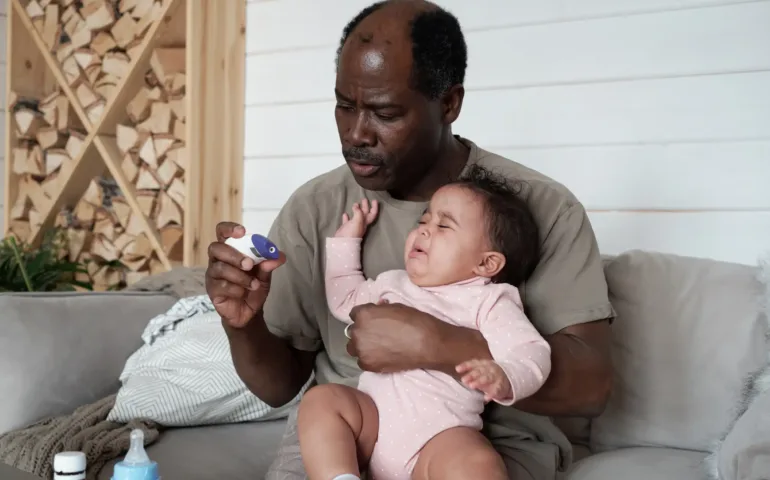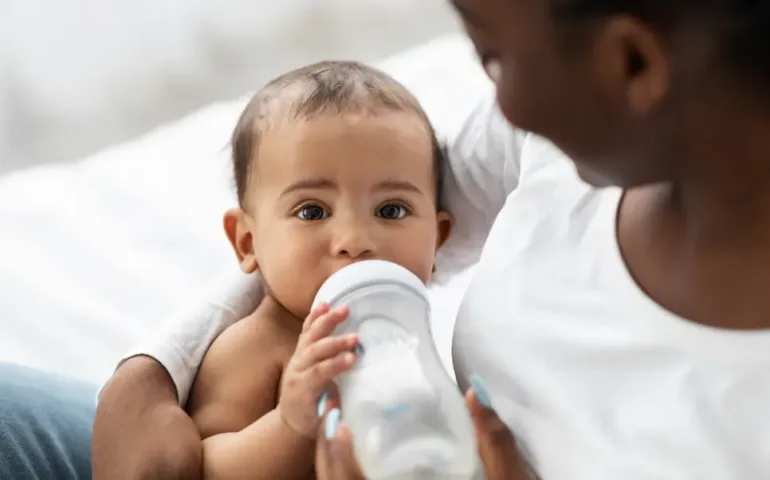
From birth to two years old, a child — in full development — is still fragile. This is the period known as the first 1000 days. Between pollutants, endocrine disruptors, and allergens, your baby — and particularly their skin — is vulnerable to external aggressions. So how can you protect their skin in everyday life?
The best laundry detergent for babies: the complete guide!
How to identify a safe and gentle detergent for your baby’s skin? Which baby detergents are recommended by pediatricians?
Your baby goes from a liquid, protected, and sterile environment (amniotic fluid) to an air-filled environment full of various aggressions: thermal, mechanical, microbial… Still immature, their skin is especially receptive to these daily micro-aggressions. Even the detergent used to wash their clothes can pose a problem for such delicate skin.
So, how can you be sure to choose the right detergent for your baby? By focusing on four key points:
- A hypoallergenic detergent: made with substances that cause little to no allergic reactions,
- If possible, eco-labeled: carrying a certified ecological label, ensuring environmentally friendly manufacturing and containing as few toxic substances as possible for your baby,
- With natural cleaning agents: whenever possible, always prefer natural ingredients for your baby — chemical products are generally irritating for their skin,
- And especially fragrance-free: for the same reasons mentioned above — fragrance usually means chemicals, which can irritate your baby’s skin.
A little tip: it’s entirely possible to make your own baby detergent using natural products like Marseille soap. You can even replace fabric softener with a few tablespoons of white vinegar.
A thousand and one labels
Now that we know what to look for in the perfect baby detergent, we need to know how to identify these elements. Many detergents claim to be hypoallergenic or eco-friendly, but how can you verify that ?
Hypoallergenic labels
Ready for a little label hunt? You’ll quickly notice that there are a thousand and one labels — each meaning something different. To identify a hypoallergenic product, look for labels from:
- The European Centre for Allergy Research Foundation (ECARF), which has awarded its label to four detergent brands (LeChat, Henkel, Persil, and Rainett Zero).
- The Association for Clinical Research in Allergy and Asthmology (Arcaa), which recommends detergents from the brands l’Arbre Vert and l’Héritage (Minidou and Bonux product lines).
Environmental labels
Environmental labels show which products to choose for responsible consumption, but in our case, they can also help identify detergents with the fewest toxic substances — ideal for your baby. There are many labels, and it can be hard to know which ones to trust. Luckily, the French Agency for Ecological Transition (ADEME) has listed them all online.
When it comes to detergents, here are the four green labels recommended by ADEME:
- Ecocert,
- European Ecolabel,
- Nature & Progrès,
- Sustainable Cleaning.
To choose your baby’s detergent, we therefore recommend opting for a labeled brand, ideally with one (or several) of the hypoallergenic and/or environmental labels mentioned above.
What are the benefits of a hypoallergenic baby detergent?
As mentioned in the introduction: from birth to 2 years old, babies are still very sensitive to external aggressions. This is due to the sensitivity of their skin. During this period, it is four times thinner than that of adults, and the surface-to-weight ratio is different from ours.
As a result, a baby’s skin is much more permeable than an adult’s. It’s therefore more likely to absorb toxic substances. Frequent and repeated use of certain products that come into direct contact with their skin has a high chance of causing irritation.
Choosing a hypoallergenic, eco-friendly detergent made without synthetic, chemical, or petrochemical ingredients helps limit your child’s skin problems (you’ll already have enough to manage with rashes, small spots, and cradle cap!).
Which ingredients should be avoided in baby detergents?
So, why can’t we just use any detergent? Quite simply because some of them contain ingredients that should be avoided for your baby’s skin (and sometimes even for adults!).
We’re talking particularly about:
➡️Allergenic ingredients: such as detergents, certain preservatives, and many fragrances…
➡️Synthetic, chemical, and/or petrochemical ingredients: phosphates and other phosphorus-based substances, genetically modified organisms (GMOs)…
Good to know: it’s also best to avoid fabric softeners, which can irritate your baby’s skin. You can, however, replace them with a few drops of white vinegar!
Want to learn more? Feel free to download the May app, where you’ll find plenty of resources to support and guide you throughout your journey as a new parent.
Is it necessary to use a different detergent for baby clothes?
As we’ve seen, a baby detergent should have a very specific list of ingredients to minimize risks for their more delicate skin. As you’ll notice when studying the composition and labels of “baby” detergents, few of them meet all the recommendations mentioned above…
Many so-called “baby detergents” use this label merely as a marketing argument, without necessarily offering a formula suited to your baby’s needs. We therefore recommend checking the composition and choosing labeled brands.
And once you’ve found the perfect baby detergent, there’s no need to clutter your home with two different ones! Choosing a detergent for your baby’s laundry is also the perfect opportunity to take care of your own skin. Because yes, a detergent suitable for babies is still detergent — you can absolutely wash your own clothes with it.
What tips should you follow to wash your baby’s clothes effectively yet gently?
You’ve got your baby detergent ready (and probably a mountain of laundry too)… Now what? Are there specific settings for your washing machine? Yes! Don’t worry — just three:
➡️Use a long cycle to make sure all detergent residue is removed. Some washing machines even have a baby or “baby care” program.
➡️Ensure the laundry is thoroughly rinsed. Detergent residue, even from baby-specific products, can still irritate the skin if not properly rinsed.
➡️Measure carefully. We often tend to use too much detergent — either to ensure everything is perfectly clean or simply to enjoy a stronger scent — but that’s a mistake. One dose is enough.
A baby detergent should therefore be both hypoallergenic, environmentally friendly, and fragrance-free. Ideally, choose labeled products and use long rinse cycles to ensure laundry that’s gentle and non-irritating for your baby’s skin.
–
Photo: NataKor5
This text was translated from French by an artificial intelligence. The information, advice, and sources it contains comply with French standards and may therefore not apply to your situation. Make sure to complement this reading by visiting the May US/UK app and consulting the healthcare professionals who are supporting you.




